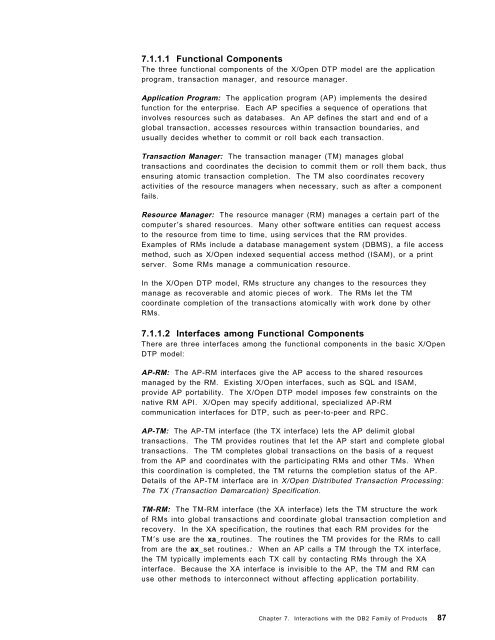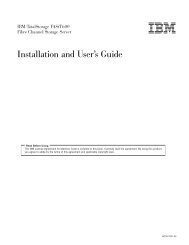Addressing OLTP Solutions with CICS: The Transaction Server ... - Ibm
Addressing OLTP Solutions with CICS: The Transaction Server ... - Ibm
Addressing OLTP Solutions with CICS: The Transaction Server ... - Ibm
Create successful ePaper yourself
Turn your PDF publications into a flip-book with our unique Google optimized e-Paper software.
7.1.1.1 Functional Components<br />
<strong>The</strong> three functional components of the X/Open DTP model are the application<br />
program, transaction manager, and resource manager.<br />
Application Program: <strong>The</strong> application program (AP) implements the desired<br />
function for the enterprise. Each AP specifies a sequence of operations that<br />
involves resources such as databases. An AP defines the start and end of a<br />
global transaction, accesses resources <strong>with</strong>in transaction boundaries, and<br />
usually decides whether to commit or roll back each transaction.<br />
<strong>Transaction</strong> Manager: <strong>The</strong> transaction manager (TM) manages global<br />
transactions and coordinates the decision to commit them or roll them back, thus<br />
ensuring atomic transaction completion. <strong>The</strong> TM also coordinates recovery<br />
activities of the resource managers when necessary, such as after a component<br />
fails.<br />
Resource Manager: <strong>The</strong> resource manager (RM) manages a certain part of the<br />
computer′s shared resources. Many other software entities can request access<br />
to the resource from time to time, using services that the RM provides.<br />
Examples of RMs include a database management system (DBMS), a file access<br />
method, such as X/Open indexed sequential access method (ISAM), or a print<br />
server. Some RMs manage a communication resource.<br />
In the X/Open DTP model, RMs structure any changes to the resources they<br />
manage as recoverable and atomic pieces of work. <strong>The</strong> RMs let the TM<br />
coordinate completion of the transactions atomically <strong>with</strong> work done by other<br />
RMs.<br />
7.1.1.2 Interfaces among Functional Components<br />
<strong>The</strong>re are three interfaces among the functional components in the basic X/Open<br />
DTP model:<br />
AP-RM: <strong>The</strong> AP-RM interfaces give the AP access to the shared resources<br />
managed by the RM. Existing X/Open interfaces, such as SQL and ISAM,<br />
provide AP portability. <strong>The</strong> X/Open DTP model imposes few constraints on the<br />
native RM API. X/Open may specify additional, specialized AP-RM<br />
communication interfaces for DTP, such as peer-to-peer and RPC.<br />
AP-TM: <strong>The</strong> AP-TM interface (the TX interface) lets the AP delimit global<br />
transactions. <strong>The</strong> TM provides routines that let the AP start and complete global<br />
transactions. <strong>The</strong> TM completes global transactions on the basis of a request<br />
from the AP and coordinates <strong>with</strong> the participating RMs and other TMs. When<br />
this coordination is completed, the TM returns the completion status of the AP.<br />
Details of the AP-TM interface are in X/Open Distributed <strong>Transaction</strong> Processing:<br />
<strong>The</strong> TX (<strong>Transaction</strong> Demarcation) Specification.<br />
TM-RM: <strong>The</strong> TM-RM interface (the XA interface) lets the TM structure the work<br />
of RMs into global transactions and coordinate global transaction completion and<br />
recovery. In the XA specification, the routines that each RM provides for the<br />
TM′s use are the xa_routines. <strong>The</strong> routines the TM provides for the RMs to call<br />
from are the ax_set routines.: When an AP calls a TM through the TX interface,<br />
the TM typically implements each TX call by contacting RMs through the XA<br />
interface. Because the XA interface is invisible to the AP, the TM and RM can<br />
use other methods to interconnect <strong>with</strong>out affecting application portability.<br />
Chapter 7. Interactions <strong>with</strong> the DB2 Family of Products 87
















